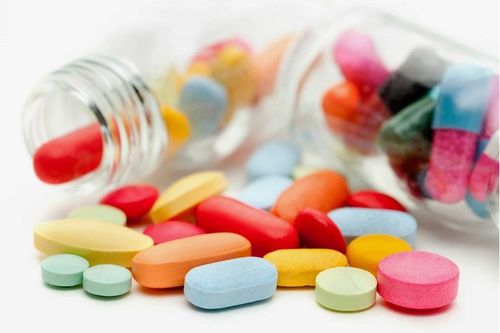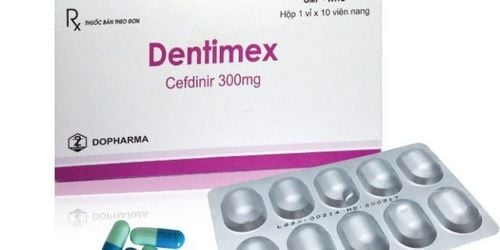This is an automatically translated article.
Haginir 125mg contains the active ingredient Cefdinir and other excipients in a sufficient amount. The drug is used in the treatment of mild to moderate bacterial infections such as pharyngitis, tonsillitis, acute maxillary sinusitis, acute otitis media, uncomplicated skin infections and community-acquired pneumonia.
1. What is Haginir 125? The effect of the drug Haginir 125
1.1. Pharmacodynamics of the drug Haginir 125mg Pharmaceutical substance Cefdinir is a semi-synthetic antibiotic belonging to the 3rd generation Cephalosporin group, which kills bacteria by inhibiting bacterial cell wall synthesis. The active ingredient Cefdinir is relatively stable to most beta-lactamases produced by Gram-negative and Gram-positive bacteria. Many bacteria are resistant to penicillin and some cephalosporins but are still susceptible to cefdinir. Some strains of the following bacteria are susceptible to cefdinir:
Gram-positive aerobic bacteria:
Staphylococcus aureus (including beta-lactamase-producing strains, which are not active against methicillin-resistant staphylococci). Streptococcus pneumonia (including penicillin-sensitive strains only). Streptococcus pyogenes. Gram-negative aerobic bacteria:
Haemophilus influenzae (including beta-lactamase-producing strains). Haemophilus parainfluenzae (including beta-lactamase-producing strains). Moraxella catarrhalis (including beta-lactamase-producing strains). Gram-positive anaerobes: Staphylococcus epidermidis (methicillin-sensitive strains), Streptococcus agalactiae, Viridan group streptococcus strains. But it has no effect on Enterococcus bacteria and methicillin-resistant Staphylococcus strains.
Gram-negative anaerobes: Citrobacter diversus, Proteus mirabilis, Escherichia coli, Klebsiella pneumonia. But it has no effect on strains of Pseudomonas and Enterobacter bacteria.
1.2. Pharmacokinetics of Haginir 125mg After oral administration of Haginir 125mg, Cefdinir is absorbed from the gastrointestinal tract, peak serum concentrations are reached after 2 to 4 hours. The bioavailability of Haginir 125mg is about 16-25%.
Haginir 125mg is widely distributed in body tissues and about 60-70% of the drug is bound to plasma proteins. Cefdinir is virtually unchanged and is excreted by the kidneys with a half-life of 1.7 hours. Active Cefdinir is removed by hemodialysis.
2. What disease does Haginir 125 treat?
Haginir 125mg is indicated in the treatment of mild to moderate infections caused by susceptible bacteria causing the following diseases:
For children from 6 months to under 13 years old: pharyngitis, acute maxillary sinusitis, tonsillitis, acute otitis media, uncomplicated skin and skin structure infections. For adults and children over 13 years: Pharyngitis and tonsillitis, acute maxillary sinusitis, exacerbation of chronic bronchitis, uncomplicated bacterial infections, community-acquired pneumonia.
3. Usage and dosage of Haginir 125
3.1. How to use Haginir 125 Haginir 125mg is taken orally. Mix Haginir 125 with enough water (about 5 - 10 ml of water for 1 pack), stir well before drinking. 3.2. Dosage of Haginir 125 The total daily treatment dose for infectious diseases is 14mg/kg body weight/day (maximum 600mg/day).
Treatment dose for children from full 6 months to under 13 years old:
Pharyngitis, tonsillitis, the treatment dose is 7 mg/kg body weight x 2 times/day, for a period of 5 to 10 days. Or 14 mg/kg body weight/day, for 10 days. Acute maxillary sinusitis treatment dose is 7 mg/kg body weight x 2 times/day for 10 days. Or 14 mg/kg body weight/day, for 10 days. Acute otitis media treatment dose is 7 mg/kg body weight x 2 times/day, for a period of 5 to 10 days. Or 14 mg/kg body weight/day, for 10 days. Uncomplicated skin infections treatment dose is 7 mg/kg body weight x 2 times/day for 10 days. For patients with renal failure (Clcr < 30 ml/min) the therapeutic dose is 7 mg/kg body weight/day. The therapeutic dose for children aged 13 years and over or over 43kg and adults is recommended to use the dosage form suitable for the following dosage fractions:
Pharyngitis and tonsillitis, the therapeutic dose is 300 mg x 2 times/day, for a period of 5 to 10 days. Or 600 mg x 1 time / day, for a period of 10 days. Acute exacerbation of chronic bronchitis, the treatment dose is 300 mg x 2 times / day, for a period of 5 to 10 days. Or 600 mg x 1 time / day, for a period of 10 days. Acute maxillary sinusitis treatment dose is 300 mg x 2 times / day, for a period of 10 days. Or 600 mg x 1 time / day, for a period of 10 days. Community-acquired pneumonia treatment dose is 300 mg x 2 times / day, for 10 days. Uncomplicated skin and skin structure infections treatment dose is 300 mg x 2 times / day, for a period of 10 days. For people with renal failure (Clcr < 30 ml/min): 300 mg x 1 time/day. Note: The therapeutic dose as described above is for reference only. The dose of treatment depends on the individual's condition and disease progression. To get the right therapeutic dose, you need to consult your treating doctor or medical professionals.
3.3. In case of overdose/missing dose In case of overdose: Manifestations of Haginir 125 overdose include nausea, vomiting, epigastric pain, diarrhea and convulsions. Treatment of drug overdose is mainly to treat symptoms and remove the drug from the body. Doctors may perform hemodialysis to remove drugs from the blood. In case of an emergency, immediately take the user to the nearest medical facility for timely and correct treatment. In case of missed dose: You should try to take the next dose as soon as you remember. However, if the time for taking Haginir 125 to make up for the next dose is too short, skip the missed dose and continue with the dosing schedule. Do not use a double treatment dose of Haginir 125 to make up for a missed dose.
4. Undesirable effects of Haginir 125 mg
Unwanted effects may be encountered when using Haginir 125 mg:
Bacterial infections: Skin candidiasis, vulvar and vaginal candidiasis, bacterial vaginosis. Lymphatic and blood system disorders: Decreased white blood cell count. Nervous system disorders: Hyperactivity may occur. Digestive system disorders: Diarrhea, vomiting, abdominal pain, indigestion, nausea, abnormal stools. Skin and subcutaneous tissue disorders: Rash, patchy rash. Examination: Increased aspartate aminotransferase. You need to inform the treating doctor about the unwanted effects encountered when using Haginir 125 mg.
5. Drug interactions of Haginir 125 mg
Patients should take Haginir 125 mg at least 2 hours after taking antacids or iron preparations, because of reduced bioavailability when taken together. Probenecid causes inhibition of renal excretion of cefdinir. Effects on laboratory test results: False-positive results can occur when sugar is found in the urine with Benedict's solution, Fehling's solution and Clinitest's solution.
6. Some notes when using Haginir 125
Before using Haginir 125 you need to carefully read the instructions for use or refer to the information below.
6.1. Contraindications of the drug Haginir 125 Haginir medicine 125mg is contraindicated in people who are sensitive to Cephalosporin drugs or any of its ingredients.
6.2. Precautions for the use of Haginir 125 Before starting treatment with Haginir 125, the treating doctor often carefully explores the patient's history of allergy to antibiotics such as Cephalosporins, Penicillins or other drugs. Long-term use of Haginir 125 can lead to bacterial and fungal superinfection; In particular, Clostridium difficile infection causes diarrhea and colitis. Use Haginir 125 until the end of the treatment dose, even if the symptoms disappear after only a few days of treatment. Stopping Haginir 125 too soon can cause the bacteria to continue to grow, leading to a recurrence of the infection that cannot be treated with Cefdinir or another antibiotic. Precautions for use: The safety and effectiveness of Haginir 125 in children under 6 months of age have not been established. Careful for people with diabetes and people with phenylketonuria because of the Aspartame content. Effects on Pregnancy: Studies in experimental animals have shown that Haginir 125 is relatively safe to use during pregnancy. However, there are no adequate studies in pregnant women, so use the drug only when clearly needed. Lactation: After a single dose of 600 mg, Haginir 125 was not detected in breast milk. Use caution when using Haginir 125 during lactation. Ability to drive and use machines: Cefdinir can cause headaches and dizziness, so you need to be careful when driving or operating machinery. Haginir 125mg medicine contains the active ingredient Cefdinir is used in the treatment of mild to moderate infections such as pharyngitis, tonsillitis, acute maxillary sinusitis, acute otitis media, uncomplicated skin infections and community-acquired pneumonia.
Follow Vinmec International General Hospital website to get more health, nutrition and beauty information to protect the health of yourself and your loved ones in your family.
Please dial HOTLINE for more information or register for an appointment HERE. Download MyVinmec app to make appointments faster and to manage your bookings easily.













